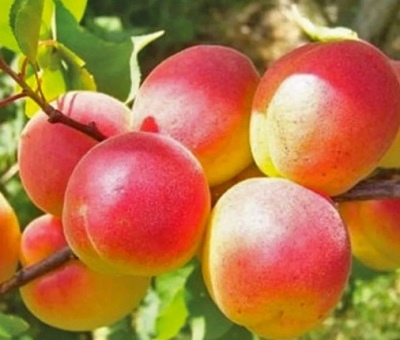
- Tree height, m: 3
- Escapes: annuals, thin
- Flowers: white, medium-sized
- Fruit weight, g: 50
- Fruit shape: rounded or rounded-oval, with slight compression and bevelling of the apex and compression of the sides
- Skin : without shine, with pubescence
- Fruit color: straw yellow
- Pulp color : yellow
- Pulp (consistency): tender and relatively juicy
- Fruit taste: harmonious combination of sugars and acids, pineapple
Experienced summer residents and farmers, choosing apricot varieties for cultivation, often prefer hybrid varieties with good taste and quick adaptation to growing conditions. These varieties include Peach apricot.
Description of the variety
Apricot Peach is a medium-sized tree that grows up to 3 meters in height in a favorable environment. The tree has a spreading, semicircular crown shape, not too thickened with small bright green foliage.
A feature of the tree is the increased fragility of the branches, which can break off under the weight of the fruit, as well as the pronounced roughness of the brown-brown bark of the trunk and shoots. To avoid deformation of the branches, it is enough to install supports during the fruiting period. Apricot Peach is a fast-growing tree, so in 5 years the tree grows and gains strength.
The flowering period of the fruit crop begins in mid-May, so the tree is not afraid of return spring frosts. At this time, the neat crown is densely covered with small snow-white flowers that attract with a pleasant aroma.
Fruit characteristics
This variety is medium-sized. On a healthy tree, apricots weighing 50 grams ripen. The fruit has a regular round-oval shape, slightly compressed on the sides, and a beautiful color - straw-yellow without blush. Sometimes chaotic orange-colored subcutaneous dots appear on the surface of the fetus. Fruit peel is dense, velvety, without shine, but with a noticeable edge and tuberosity. The abdominal suture is clearly visible. The fruit is kept on a short stalk.
Due to their excellent taste, apricots have a universal purpose - they are eaten fresh, frozen, dried, processed into jams, preserves, compotes, and are also widely used in cooking (pie fillings, sweet dressings).
The harvested fruits tolerate transportation well, and can also be stored for a long time - up to 2 weeks at a temperature of 8-10 degrees Celsius.
Taste qualities
The apricot variety has a delicious taste and excellent marketability. The light yellow flesh has a fleshy, tender, slightly fibrous and moderately juicy texture, complemented by a bright tropical aroma. Fruit taste is harmonious - sweet, goes well with pineapple notes. The small pit is easily separated from the apricot pulp.
Ripening and fruiting
Apricot Peach is medium late. The tree begins to bear fruit in the 4th year after planting. You can taste the first fruits in the third decade of July. The tree has a prolonged ripening period, since apricots ripen at the same time. The phase of active maturation begins at the end of July and lasts until mid-August. It is not recommended to overexpose ripe apricots on the tree, as they can crumble.

Yield
The variety has high yields. In the first harvest season, you can count on 20-30 kg of fruit, but over time, the figure will increase. The maximum yield is about 140 kg per tree.
Self-fertility and the need for pollinators
The apricot tree is self-fertile, so it does not need additional cross-pollination. For a good harvest, it is enough to plant one apricot seedling.
Growing and care
It is better to plant an apricot seedling in the spring (in April), when the air and soil are well warmed up. For this, a two-year-old seedling is purchased with a developed rhizome, consisting of 2-3 processes, and a height of 110-120 cm. The planting is carried out away from other fruit trees. A good neighbor for the Peach apricot is the dogwood. Due to the fact that the tree loves space, it is recommended to maintain a distance between plantings of 4-5 meters.
Intensive agricultural technology consists of standard measures: irrigation, especially intensive during dry periods, spring and autumn water-charging irrigation, fertilization from the fifth year of growth, loosening the soil, weeding and removing weeds in the near-stem zone, crown formation (over 3 years), sanitary removal of dry and damaged branches, prevention of diseases, mulching with spruce branches, whitewashing, preventing burns, preparation for winter. For protection from rodents, a fine-grained metal mesh is installed.



Disease and pest resistance
Apricot Peach is quite resistant to many fungal diseases. In addition, the tree tolerates clasterosporium disease, but is often exposed to powdery mildew. A decrease in immunity occurs only when the growing conditions do not match. Insecticide treatments will help protect against pest infestation.

Winter hardiness and the need for shelter
The frost resistance of the tree is average, so the fruit crop is able to withstand short drops in temperature down to -15 ... 18 degrees. Young trees growing in the central regions need shelter. For this, spunbond or agrofibre is used. Planted apricots in the south do not need additional protection from the cold in winter.
Location and soil requirements
It is comfortable for an apricot tree to grow on the southern side of the site with nutritious, loose, moisture-permeable and breathable soil, which has a neutral acidity level. It is worth remembering that the flow of groundwater must be deep.The best for the tree will be black soil and sandstone.































































